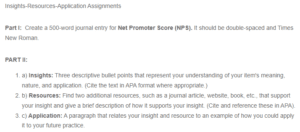Net Promoter Score
Introduction
The Net Promoter Score (NPS) in the hospitality sector is used to determine customers’ willingness to refer a product or service in the sector to a colleague or a friend because they liked it. An NPS presents hospitality service providers with an opportunity to assess their customers’ needs. An NPS in the tourism sector presents approaches to improving the sector as a whole and strategies that may be implemented to improve individual aspects of tourism. A complete NPS presents the metrics key to fulfilling a critical customer need in the tourism sector. Hire our assignment writing services in case your assignment is devastating you. We offer assignment help with high professionalism.
Customer Service
The success or failure of businesses and destinations within the tourism and hospitality industry primarily depends on service (Westcott et al., 2014). Some businesses do better than others when it comes to service provision. There is a need to provide outstanding services to survive in a globally competitive environment. A key success factor in the tourism industry is the human element in customer experience. To achieve this, hoteliers in tourist attraction destinations encourage their staff to improve customer experience (Westcott et al., 2014). As such, customer relationship skills are trained internally and throughout the school system.
Reaching the Consumer
Marketers have a wide variety of marketing and promotional channels from which to choose. These include traditional communication channels and modern online platforms. One of the most successful and popular marketing channels is mass media. Mass media includes television stations, newspapers, and radio. Tourist destinations and hotels post messages featuring their services and products on these channels. The advantage of marketing through mass media is that tourist destinations access a wide segment of target markets. On the other hand, one of the disadvantages associated with mass media is the difficulty of targeting specific market segments.
Also, online marketing platforms are equally important in reaching potential clients. Research shows that online platforms such as social media are three times as important as travel agents in promoting tourist destinations (Cimbaljević, 2015). The large traffic of subscribers in social media networks is one of the contributing factors to the growing importance of social media. With three billion people using different social media networks, social media presents an effective promotional strategy with a high score value.
Destination Competitiveness
Destination competitiveness also determines whether people will recommend a tourist destination to others. Destination competitiveness includes organization, services, equipment, and infrastructure (Tsai et al., 2009). Customers who are satisfied with such offerings will recommend a tourist destination to their friends. Particular considerations for destination competitiveness include the ability of destination users to provide a high standard of living to users. Also, a competitive destination must consist of value-added products that enhance the sustainability of its resources while retaining the destination’s competitive position.
The quality of the tourist experience is also a critical factor in tourism issues. Destinations offering raw heritage have a highly competitive advantage over those with eroded heritage (Tsai et al., 2009). Most destinations emphasize retaining destinations in their original form to retain heritage and authenticity. For instance, tourist operators managing historical buildings may desist from painting them to preserve the heritage.
References
Cimbaljević, M. (2015). Social media marketing in tourism and hospitality. Annals of Tourism Research, 54, 236–238. https://doi.org/10.1016/j.annals.2015.05.006.
Tsai, H., Song, H., & Wong, K. K. F. (2009). TOURISM AND HOTEL COMPETITIVENESS RESEARCH. Journal of Travel & Tourism Marketing, 26(5-6), 522–546. and online. https://doi.org/10.1080/10548400903163079.
Westcott, M., Bird, G., Briscoe, P., Freeman, R., Thomlinson, E., Wilson-Mah, R., & Robinson, L. (2014). Introduction to Tourism and Hospitality in BC. BCcampus.
ORDER A PLAGIARISM-FREE PAPER HERE
We’ll write everything from scratch
Question

Net Promoter Score
Insights-Resources-Application Assignments
Part I: Create a 500-word journal entry for Net Promoter Score (NPS). It should be double-spaced and Times New Roman.
PART II:
- a) Insights: Three descriptive bullet points that represent your understanding of your item’s meaning, nature, and application. (Cite the text in APA format where appropriate.)
- b) Resources: Find two additional resources, such as a journal article, website, book, etc., that support your insight and give a brief description of how it supports your insight. (Cite and reference these in APA).
- c) Application: A paragraph that relates your insight and resource to an example of how you could apply it to your future practice.

